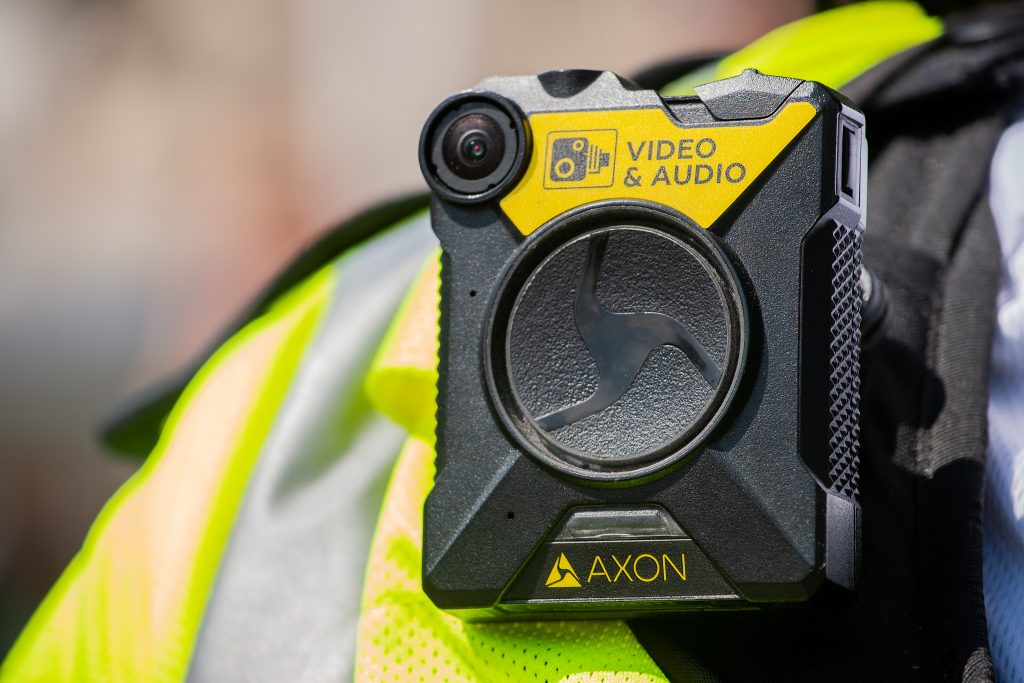
This paper reports on a study exploring the views of patients, mental health staff and senior management on the use of body-worn cameras. Ostensibly, the aim of body-worn cameras is to prevent violence on acute mental health wards by recording audio and video footage of interactions between staff and patients. This is based on tenuous evidence around the impact of their use on police and public behaviour. Starting with the introduction of body-worn cameras by police entering mental health wards (Seni’s Law), they were introduced into NHS Trusts in 2017. According to Wilson et al, they are currently in use in around 20 mental health hospitals despite ongoing concerns (Rowan Olive, 2019).
I profoundly object to the idea of body-worn cameras in acute mental health wards. For me, it is another step along the journey towards the criminalisation of mental distress, a journey which we are too far along already. When I first heard about the idea, I could only see nurses as police and prison warders. The memory of a nurse jangling his keys as he stood by the locked ward door when I was a patient came to mind. When approached to take part in the study explored in this blog, I could not bring myself to do so. Perhaps in part this was because I feared the outcome: that people might think it was a reasonable measure and I would find myself isolated in my outrage. Spoiler alert: I was relieved to read the study findings, even if I fear it will not be acknowledged in NHS Trusts’ decisions.

Body worn cameras are currently in use in around 20 mental health hospitals despite ongoing concerns.
Methods
This was a qualitative interview study carried out online and in-person across five acute wards, with participants recruited online and through professional networks. A total of 24 patients on acute wards, 25 staff on acute wards, 9 community-based service users and 6 mental health nursing directors were interviewed. Semi-structured interviews and reflexive thematic analysis were used. The study was guided by three questions:
- How do patients, staff and service managers on acute inpatient mental health wards view the use of body-worn cameras?
- What are the key benefits and harms of using body-worn cameras on mental health inpatient wards?
- Are there alternative measures patients and/or staff feel would be more appropriate to reduce violence from staff and patients?
Patient and public involvement was a key element of the study. The team included a lived experience research assistant and lived experience consultant, who facilitated a Lived Experience Advisory Panel of eight. Interestingly, the paper states that “those involved in the study from a lived experience perspective were predominantly ambivalent” about the use of body-worn cameras, but does not state the views of the other team members.

Patient and public involvement was a key element of this study. The paper states that “those involved in the study from a lived experience perspective were predominantly ambivalent” about the use of body-worn cameras.
Results
Overall, body-worn cameras were viewed as an ‘emotive’ topic and interviewees were ‘conflicted’ about their use. Distrust, ambivalence, and uncertainty were expressed by many. The four key themes were identified.
1. Violence and aggression is a complex issue
The study identified a lack of shared understanding about what constitutes ‘violence and aggression’. This partly centred on the nature of agency: that some staff perceived acts as deliberate where others might see it as an expression of distress with multiple causes or triggers.
2. Being safe: improving physical safety
This theme speaks to the main aim for wearing the cameras: to deter violence and improve safety. However, with reference to the first theme, this would only be effective if people were able to adjust their behaviour in the knowledge that they were being filmed. People talked about alternative forms of de-escalating incidents that might become violent. Both staff and patients were concerned that wearing cameras would become a substitute for good care.
3. Feeling safe: precarious psychological safety
Findings suggest body-worn cameras will have particular implications for patients who “already feel criminalised in an environment with asymmetrical power imbalances between staff and patients”.
4. Culture of mistrust
The paper highlights a lack of trust between patients and staff, potentially exacerbated by body-worn cameras. An imbalance of power between staff and patients is accentuated by staff both wearing and controlling the cameras.

The study identified a lack of shared understanding about what constitutes ‘violence and aggression’. Some staff perceived acts as deliberate, while others perceived them as an expression of distress with multiple causes or triggers.
I found these themes interesting and nuanced in their understanding of the situation facing people as inpatients as well as members of staff. Knowing how I felt in hospital, albeit some years ago, the power that staff hold over you cannot be underestimated with or without body-worn cameras. I remember smashing a cup once in frustration at being followed by a male patient. Nurses took me to the isolation room where they said I would end up if I did something like that again. Such was my fear that I could not approach them to ask for help – I didn’t expect them to do anything. Undoubtedly, the underlying causes of violence and aggression are obscured by a focus on policing individual incidents. A culture of mistrust and ‘precarious psychological safety’ are ultimately exacerbated by these visible symbols of scrutiny.
Conclusions
In conclusion, the study suggests that most patients and staff do not believe that body-worn cameras will achieve their aim of preventing violence and aggression. They perceive violence and aggression to have complex underlying causes, including unmet needs in the immediate as well as the wider context. Indeed, there is a risk that body-worn cameras will “mask structural issues” (p.19) and “exacerbate epistemic injustice” rather than prevent violence and aggression. The direction of the gaze of scrutiny is significant here: it is assumed that the cameras are directed at the patients, not at the staff, and staff are in control of them. Aside from the obvious power imbalance, this has the risk of completely missing events preceding that moment, including poor behaviour on the part of staff.
Ultimately, body-worn cameras are a tool for control dressed up as a safety initiative; they are a quick and dirty way to reduce incidents on paper without bothering to address their causes.
– Rowan Olive, 2019
The importance of feeling safe is an issue that has preoccupied me for a long time in relation to inpatient care (Faulkner, 2005; Faulkner, 2018). What hope is there for recovery if you do not feel safe? A quick scan of the literature demonstrates the wide range of issues affecting safety (Thibault et al, 2019). As I pointed out in my previous Mental Elf blog (Faulkner, 2018), the systemic focus on risk instead of safety lends itself to locating risk within individuals, which in turn leads to a greater tendency to stereotype those at risk on the basis of race, gender and diagnosis. Some staff in this study believed people diagnosed with personality disorder would have greater agency and would be more likely to alter their behaviour in response to being filmed. This is an example, in my view, of the continued epistemic injustice afforded people with this diagnosis. Similarly, structural racism places black service users at greater risk of coercive practices, making services far from safe for them. Further research might help to identify the demographics of the patients that prompt staff to switch on their cameras.

The direction of the gaze of scrutiny is significant. Cameras are directed at the patients, not at the staff, and staff are in control of them, creating an obvious power imbalance.
Strengths and limitations
This is a qualitative study which renders it vulnerable to being disregarded by decision-makers looking for strong (usually quantitative) evidence. However, it is a robust qualitative study in its substantial sampling of patients and staff across five hospitals and bringing together different perspectives.
With regard to the study itself, I would be interested to know how many interviews were carried out by the lived experience researcher and whether it made a difference to the issues raised. In other work (Gillard et al, 2009), this has been a useful subject for exploration, demonstrating the value of lived experience researchers in eliciting more honest and critical views. In the interests of equality and coproduction, I would have expected the entire research team to declare their perspectives on the use of body-worn cameras, not just those with lived experience.
The only real criticism I have of the paper is the comparative weakness of its concluding paragraph, which talks of balancing potential benefits with potential harms. Given the power of the themes that arose in the study, this seems almost too neutral. Perhaps, like me, the authors are aware that NHS Trusts have already begun to employ body-worn cameras and their main hope is that Trusts will give some attention to the ethical issues raised in this paper.

Interviews conducted by lived experience researchers can elicit more honest and critical views from participants; it is unclear in this study how many interviews were conducted by lived experience researchers.
Implications for practice
Although I would love to think that this study will have implications for practice, I am sadly not optimistic. I would like to think that those responsible for implementing body-worn cameras will read this paper, take note of the ethical issues and concerns involved, and invest in alternatives such as de-escalation techniques and peer support. I would hope that this paper will promote the issue of psychological or felt safety, and highlight the corrosive impact of a culture of mistrust. But, if we have anything to learn from the introduction of SIM (Serenity Integrated Monitoring), it is that Trusts are more persuaded by the value of greater scrutiny than they are by improved care and safety. Very much in the spirit of body-worn cameras, SIM introduced increased policing into mental health care without robust evidence (see blog by Wren Aves, 24 March 2023). Both initiatives are indicative of a system giving up on promoting safety through good care and compassion, and prioritising short-term fixes for risk.
Statement of interests
I have stated my personal perspective on body-worn cameras, and I make no apology for infusing this blog with my views. If you have been a patient on a ward that felt like prison, you might also feel this measure of passion about yet another initiative more redolent of regulation and scrutiny than care.
Links
Primary paper
Wilson, K., Foye, U., Thomas, E., Chadwick, M., Dodhia, S., Allen-Lynn, J., … & Simpson, A. (2023). Exploring the use of body-worn cameras in acute mental health wards: A qualitative interview study with mental health patients and staff. International Journal of Nursing Studies, 140, 104456. https://doi.org/10.1016/j.ijnurstu.2023.104456
Other references
Berzins et al. (2018) Service user and carer involvement in mental health care safety: raising concerns and improving the safety of services. BMC Health Services Research 18:644 https://doi.org/10.1186/s12913-018-3455-5
Faulkner, A (2005),”Institutional conflict: the state of play in adult acute psychiatric wards”, The Journal of Adult Protection, Vol. 7 Iss 4 pp. 6 – 12.
Faulkner, 2018 ‘Whose Safety is it Anyway? Service user and carer involvement in mental health care safety. Mental Elf blog on Berzins et al, 2018. www.nationalelfservice.net/populations-and-settings/patient-safety/whose-safety-is-it-anyway-service-user-and-carer-involvement-in-mental-health-care-safety/
Gillard, S. et al (2009) What difference does it make? Finding evidence of the impact of mental health service user researchers on research into the experiences of detained psychiatric patients. Health Expectations, 13, pp.185–194.
Rowan Olive, R. (2019) ‘If anyone is to be wearing recording equipment on psychiatric wards, it should be the patients’. Mental Health Today, 20 May 2019.
Thibaut B, Dewa LH, Ramtale SC, et al. Patient safety in inpatient mental health settings: a systematic review. BMJ Open 2019;9:e030230. doi:10.1136/bmjopen-2019-030230
Wren Aves blog: Serenity Integrated Mentoring: Past, Present and Future, 24 March 2023 www.psychiatryisdrivingmemad.co.uk/post/sim-past-present-and-future
Photo credits
- Photo by Miłosz Klinowski on Unsplash
